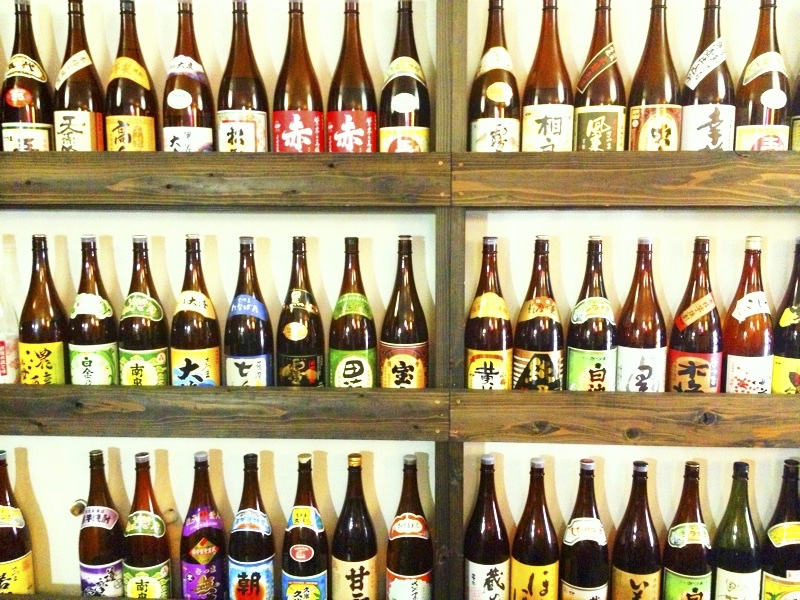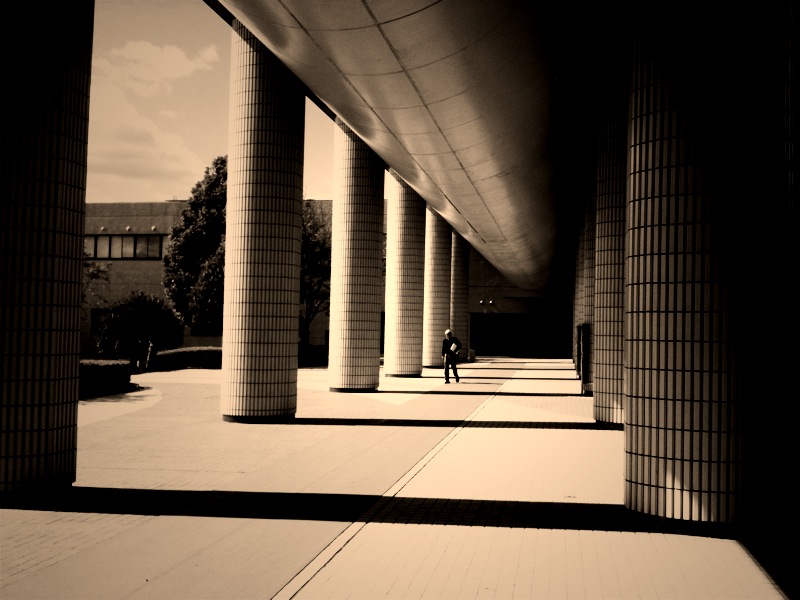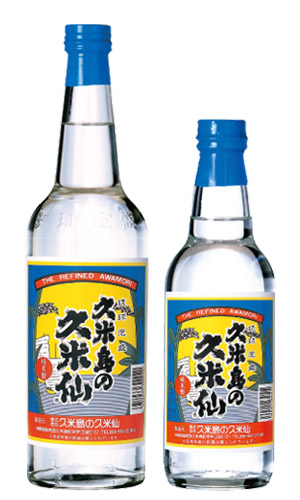More a list of awamori distilleries than a song, “Moriawarō” is, I believe, the first tune Kiiyama Shōten did at the request of the Okinawa Prefecture Union of Distillers (沖縄県酒造組合). (Their second (?) was Kampai Shanshan, which I have also translated.) The title is a play on awamori (泡盛), with the characters inverted to sound like moriagarō (盛り上がろう) which can be loosely translated as “Let’s party!”
I will be working on the translation over the next few weeks, so drop by every now and then. Also, I have added links to each shuzō when possible.
A quick note about awamori is helpful before jumping into the lyrics of the song.
During the Ryūkyū Kingdom (1429-1879), the making of awamori was only permitted in Shurisanka (首里三箇), three villages just south and southeast of Shuri (or “Shui”), the capital of the kingdom—Torihori (鳥堀), Sakiyama (崎山) and Akata (赤田). Today, you can still find a handful of distilleries in the area, including Zuisen and Shikina. Another awamori maker, Sakimoto (咲元), has since moved out of the area. All that remains of that former distillery is a simple, easy-to-miss stela. The 40 people licensed to engage in the making of awamori were given the raw materials from the ōfu (王府), or royal administration, and delivered the awamori they then produced to the ōfu as a form of tax.
Awamori produced outside of the Shurisanka generally began as moonshine. From the Meiji Period on (1868-), however, regulations on the brewing and distillation of alcohol were lifted. Production at local distilleries remained small and was for the most part consumed locally. Today there is a deep attachment and loyalty among Uchinānchu (Okinawans) to their shimā, or hometown’s hooch.
Today there are, I believe, 48 distilleries in Okinawa prefecture with more than 500 different brands and over 2000 individual products. That’s a lot of booze. By comparison, there are about 2000 whiskey distilleries in the whole of the US today. The song lists 46 distilleries. I suspect that there may have been consolidation, which may explain why Takazato, is now known as Yambaru Shuzō. I could be wrong. (Will look into this later.)
I should note that awamori enjoys a lower tax rate, compared to shōchū makers in other parts of Japan, so a typical bottle of awamori will cost less than ten bucks locally. Part of the reasoning, is that in the ritō (離島), or outlying islands of Okinawa prefecture, awamori production is one of the few industries that provides steady employment. Although 3.4% of manufacturing jobs on the main island of Okinawa are in awamori production, on Kumé-jima, that number is 26.2%. On Yonaguni-jima, it’s 23.1%; Izena-jima, 17.3%; and, Miyako-jima, 14.3%. Orion beer, Uchinā’s favorite suds also benefit from lower taxation.
And so, on we go to that “song”. The verses are a list of awamori distilleries followed by their signature product. Distilleries are given for the most part in geographical order, from the westernmost islands of Yonaguni and Hateruma, through the Yae Archipelago, then on to the southern part of the Okinawan mainland and on up in a northerly direction, then back down. I will add more information regarding the location later, so come back in a few weeks.
波照間 (泡波)、国泉 (どなん)、崎元 (与那国)、入波平 (舞富名)
Hateruma (Awanami), Kokusen (Donan), Sakimoto (Yonaguni), Irinamihira (Maifuna)
Note: Distillery name followed by its brand of awamori in parenthesis. All of these with the exception of Hateruma (of Hateruma Island) are located on the island of Yonaguni. I haven’t been there myself, but I have heard (and read) that the island of Formosa (Taiwan) can be see on clear days from Yonaguni.
仲間 (宮之鶴)、請福 (請福)、高嶺 (於茂登)、玉那覇 (玉の露)
Nakama (Miyanotsuru), Seifuku (Seifuku), Takamine (Omoto), Tamanaha (Tamanotsuyu)
Note: Most of these can be found on Ishigaki-jima.
池原 (白百合)、八重泉 (八重泉)、多良川 (王朝)、宮の華 (宮の華)
Ikehara (Shirayuri), Yaesen (Yaesen), Taragawa (Ōchō), Miyanohana (Miyanohana)
Note: Ikehara and Yaesen can be found on Ishigaki; Taragawa on Miyako-jima and Miyanohana on the neighboring island of Irabu.
沖之光 (沖之光)、池間 (太郎)、菊之露 (菊之露)、渡久山 (豊年)
Okinohikari (Okinohikari), Ikema (Tarō), Kikunotsuyu (Kikunotsuyu), Tokuyama (Hōnen)
Note: I believe all of these are located on Miyako-jima, home of the otōri binge-drinking session culture.
Chorus
色んな泡盛飲みましょう 泡盛飲んで踊りましょう
ひやさっさっ みんなで笑いましょう 泡盛飲んで 盛り泡ろう!
かんぱーい!
Let’s drink all kinds of awamori. Let’s drink awamori and dance.
Hiyasassa! Let’s laugh together. Drink awamori and “moriawarō” (party)
Cheers!
Note: Listen to enough Okinawan music and you are bound to hear the “hiyasasa” or “iyasasa” call. This is shouted during the eisa drumming and dancing performed during the Bon festival honoring the spirits of one’s ancestors. Eisa and hiyasasa are said to originate in an exclamation in Mamauya Ninbuchi (継親念仏, Gishin Nenbutsu), a nenbutsu song of Pure Land Buddhism: Eisa, eisa, hiyarugaeisa (エイサー、エイサー、ヒヤルガエイサー). You can hear the this chanted in the song I have linked to below.
まさひろ (まさひろ)、久米仙 (久米仙)、宮里 (春雨)、津波古 (太平)
Masahiro (Masahiro), Kümesen (Kumesen), Miyazato (Harusame), Tsuhako, (Taihei)
神谷 (南光)、忠孝 (忠孝)、上原 (神泉)、米島 (久米島)、沖酒協 (海乃邦)
Kamiya (Nankō), Chūko (Chūko), Uehara (Shinsen), Yoneshima (Kumesen), Okishukyō (Umi no kuni)
久米島の (久米仙)、瑞泉 (瑞泉)、咲元 (咲元)、瑞穂 (瑞穂)、識名 (時雨)、石川 (甕仕込)、神村 (暖流)
Kumejima’s (Kumesen), Zuisen (Zuisen), Sakimoto (Sakimoto), Mizuho (Mizuho), Shikina (Shigure), Ishikawa (Kameshikomi), Kamimura (Danryū)
Chorus
色んな泡盛飲みましょう 泡盛飲んで踊りましょう
ひやさっさっ みんなで笑いましょう 泡盛飲んで 盛り泡ろう!
かんぱーい!
Let’s drink all kinds of awamori. Let’s drink awamori and dance.
Hiyasassa! Let’s laugh together. Drink awamori and “moriawarō” (party)
Cheers!
Shinzato (Ryūkyū), Higa (Zampa), Chattan Chōrō (Chōrō), Heriosu (Kura)
伊平屋 (照島)、伊是名 (常盤)、山川 (珊瑚礁)、今帰仁 (古里)
Iheya (Terushima), Izena (Tokiwa), Yamakawa (Sangoshō), Nakijin (Furusato)
Note: Iheya is an island northwest of the main island of Okinawa and the northernmost point of Okinawa prefecture. It has a population of only 1,200 people. Izena is just south of Iheya. It has a population of about 1,500. Yamakawa is located on the Motobu Peninsula (near Nago) back on the main island. Nakijin can also be found on the Motobu Peninsula.
龍泉 (龍泉)、田嘉里 (まるた)、崎山 (松藤)、金武 (龍)、 恩納 (萬座)、津嘉山 (國華)
Ryūsen (Ryūsen), Takazato (Maruta), Sakiyama (Matsufuji), Kin (Tatsu), Onna (Manza), Tsukayama (Kokka)
Note: Ryūsen is in Nago City, in the center of Okinawa Island. Takazato, also known as Yambaru Shuzō, is in the northern part of Okinawa Island, near the Yambaru National Park, which I believe was just registered as a UNESCO World Heritage along with parts of the Amami Ōshima archipelago. To give you an idea of how remote the area is, it took me longer to drive there from Naha than it did to fly to Naha from Fukuoka. Sakiyama is located further south, closer to the towns of Kin and Onna.
ゴーヤー (かちゃーしー)
Gōyā (Kachāshī)
Note: Gōyā is also known as nigauri (苦瓜) in Japanese and a variety of names in English, including bitter gourd and balsam pear. Originating in Africa, it was introduced to Okinawa via China some four hundred years ago. On Miyako-jima, it is known as gōra (ゴーラ); in the Yaeyama archipelago, gōya (ゴーヤ) with a short “a”. In Kyūshū, it is known as nigagori or nigagōri. In Amami it is called nigyaguri (ニギャグリ ) or tōguri (トーグリ). In the rest of Kagoshima prefecture, it is nigagoi (ニガゴイ), dropping the “r” as is common in Kagoshima.
Kachāshī is the distinctive folk dance that people in Okinawa do. See it demonstrated here.
おしまい (むるまーさん!)
That’s all for now, Mr. Muromā!
Chorus
色んな泡盛飲みましょう 泡盛飲んで踊りましょう
ひやさっさっ みんなで笑いましょう 泡盛飲んで 盛り泡ろう!
かんぱーい!
Let’s drink all kinds of awamori. Let’s drink awamori and dance.
Hiyasassa! Let’s laugh together. Drink awamori and “moriawarō” (party)
Cheers!
嫌な事飲んで 忘れましょう 明日の仕事も頑張りましょう
ひやさっさっ みんなで笑いましょう 泡盛飲んで 盛り泡ろう!
かんぱーい!
Let’s drink and forget unpleasant things; Let’s do our best at work tomorrow
Hiyasassa! Let’s laugh together. Drink awamori and “moriawarō” (party)
Cheers!
Phew. This post took much more time than I originally intended to spend on it, and it’s still a work in progress. I need a drink!








